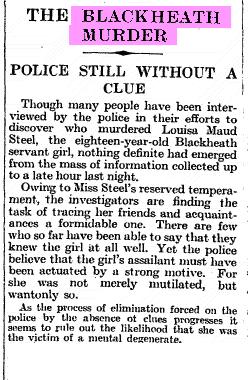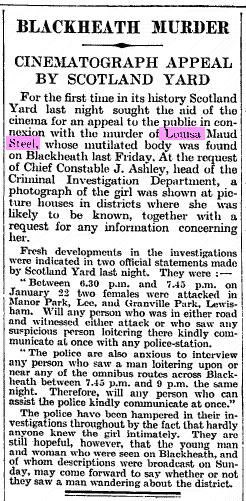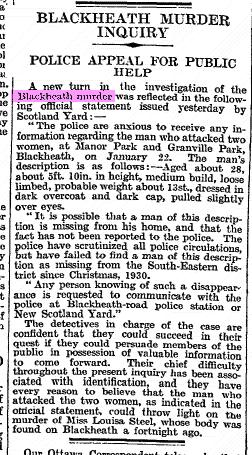
|
 |
 |
 |
 |
 |
| Author |
Message |
    
Chris Scott
Inspector
Username: Chris
Post Number: 453
Registered: 4-2003
| | Posted on Monday, September 01, 2003 - 1:15 pm: |       |
Found this reference to an entry in Virginia Woolf's diary:
On 26 January, 1931, shortly before finishing The Waves, Woolf noted in her diary her memory of the day's headlines: "Gandhi set free. Pavlova to be buried on Golders Green. Ripper murder on Blackheath."
Anyone know which murder in 1931 this refers to please?
Chris |
    
Yelarney Hibberd
Unregistered guest
| | Posted on Friday, June 11, 2004 - 11:03 pm: |       |
i'm not sure what year the yorkshire ripper struck, but could it have been him?
|
    
Busy Beaver
Sergeant
Username: Busy
Post Number: 29
Registered: 5-2004
| | Posted on Tuesday, June 29, 2004 - 5:11 am: |       |
The Yorkshire ripper was in the 1970's early 1980's. So no it was not him.
Busy Beaver |
    
Robert Charles Linford
Assistant Commissioner
Username: Robert
Post Number: 2640
Registered: 3-2003
| | Posted on Tuesday, June 29, 2004 - 11:08 am: |       |
This is from the "Times" Jan 27th 1931 :


Robert |
    
Jeffrey Bloomfied
Inspector
Username: Mayerling
Post Number: 407
Registered: 2-2003
| | Posted on Tuesday, June 29, 2004 - 10:59 pm: |       |
Hi Robert,
I have found these three accounts of the murder of Louisa Maud Steele. They are somewhat contradictory, but also intriguing in how they seem to reflect theories regarding the Ripper.
First a general account in E. Spencer Shew's A COMPANION TO MURDER (New York: Alfred A. Knopf, 1961). On pages 260 - 261:
STEELE, LOUISA MAUD, domestic servant, left her mistress's house in Lee Road, Lewisham, at about eight o'clock on the evening of Thursday, 23 January 1931, intending to return a book to a neighbour and to cal at a local chemist for some syrup of senna. She usuallly went for a walk on Thursday evenings, but as it was wet and windy, her mistress, Miss Kathleen Andrews, a music teacher, expected that she would be back at least by 9 P.M. When she had not returned by eleven o'clock, Miss Andrews, much alarmed, informed the police. Shortly before eight o'clock the next morning the dead body of Louisa Maud Steele was discovered by a lamplighter on Blackheath, within walking distance of home. The girl was lying on her back, covered by her coat; she had been strangled and there were extensive injuries to the face, neck, and body, probably caused by heavy kicks as she lay on the ground. There were also what appeared to be bite marks. The girl's clothes had been ripped off her, but there was no sign of any attempt at sexual interference. At the inquest, the Home Office pathologist, Sir Bernard SPILSBURY, said that the girl had been strangled by the length of tape treaded into the neckline of her own dress. 'In my opinion, he said,'the girl was attacked from behind and the neck of the dress was drawn forcibly backwards, while counter-pressure was made on the back of the head and neck....She would probably lose conciousness in a few seconds, so that she could offer no effectual resistance. Probably the pressure was released before death took place. Most of the injuries were inflicted during life.'
Death would ensue within five or ten minutes, he thought. Detective-Inspector Cory, the Scotland Yard officer in charge of the case, told the Coroner, Dr. H.S. Knight, that there could not be the slightest doubt that the murder was the work of a maniac. The jury returned the only possible verdict--wilful murder by a person or persons unknown. And that is the last that has ever been heard of the matter."
Or is it? Now comes the second account, which appears to have information withheld from the public (sound familiar - read on). This is from THE SCALPEL OF SCOTLAND YARD: THE LIFE OF SIR
BERNARD SPILSBURY by Douglas G. Browne and E.V.Tullett (New York: E.P.Dutton and Company, Inc., 1952) on page 362:
"Neither of those with which 1931 opened are, in fact, strictly within the scope of this chapter, but for very different reasons both should be included. The first victim, Louise Maud Steele, was not a child, but a young woman of eighteen. The circumstances of her death, however, place it in the category covering most sexual offences against children, which are the work of degenerates, whose impulses render them for the time bein insane. Miss Steele's murderer wa a certified lunatic, and he behaved like one. On the morning of January 25, this poor girl's body was found on Blackheath, stripped of clothing except for one stocking, and mutilated in a manner only to be described in a medical text-book. She had been strangled by the neck-band of her frock, and of her other injuries, which fill four of Spilsbury's cards, some of the worst were inflicted after death. The man who killed her had been released from a mental home, presumably as cured, but his own family were so frightened of him that they would not have him in the house, and it wa on their information that the police detained him on another charge before he could kill again. He was sent to Broadmoor."
Finally, there is this brief statment in MAN-HUNTERS OF SCOTLAND YARD: THE RECOLLECTIONS OF FORTY YEARS OF A DETECTIVE'S LIFE by Arthur Fowler Neil (Garden City, New York: The Sun Dial Press, Inc., 1932(?)), on page 273:
"The nude body of a young girl named Louisa Maud Steele was found on Blackheath Common early last year. She had been strangled and terribly mutilated. The murderer is still at large. It is understood in well-informed circles that an educated man of well-to-do family was strongly suspected. But proof was lacking. It was known that this man had been an inmate in a mental institution and had several times been discharged on parole as recovered, and committed to the care of his own people. Immediately after the crime he was back again in his private mental home, and the authorities will see that he does not come out again."
Shades of Druitt, Gull, Stephen, even of Kosminski or Ostrog. Also (nearly contemporary) one of the theories of the Cleveland Torso killer (who checked himself - maybe - in and out of private insane asylums). But was Ms Steele's murderer actually sent to a private asylum, or Broadmoor (which is an asylum for the criminally insane), or was Shew correct - that no body really knows who killed her.
Also, the comment of Inspector Neil makes one wonder about the inside information of his predecessors in Scotland Yard forty years before.
Especially about those suspects mentioned above, especially Druitt, Kosminski, and Ostrog.
Best wishes,
Jeff |
    
Jeffrey Bloomfied
Inspector
Username: Mayerling
Post Number: 408
Registered: 2-2003
| | Posted on Tuesday, June 29, 2004 - 11:02 pm: |       |
Postscript to a long comment:
It suddenly occurred to me - Virginia Woolf was the cousin of James Kenneth Stephen. Was it normal curiosity about murder cases or something else that drew the headline about Louisa Maud Steele's murder to Ms Woolf's attention?
Jeff |
    
Jennifer D. Pegg
Inspector
Username: Jdpegg
Post Number: 430
Registered: 2-2003
| | Posted on Wednesday, June 30, 2004 - 7:40 am: |       |
Jeff,
AHH!! I sense a conspiracy!
Seriously though it was a very interesting post. i did not know of the relationship-
Jennifer
Uncle Bulgaria,He can remember the days when he wasn't behind The Times.....
|
    
Christopher T George
Chief Inspector
Username: Chrisg
Post Number: 788
Registered: 2-2003
| | Posted on Wednesday, June 30, 2004 - 8:58 am: |       |
Hi, all
Interesting that Virginia Woolf would characterize the murder of Louisa Maud Steele, whose body was found on Blackheath Common in 1931, as a "Ripper murder". It seems if the young woman was murdered by strangling then her body extensively mutilated. As stated in Browne and Tullett, as kindly quoted by Jeff, she had been "mutilated in a manner only to be described in a medical text-book." The newspaper account so far posted does not mention the name "Ripper" although Virginia Woolf could have read another account that did use the term. It should also be acknowledged, of course, that, as we have seen, many post-1888 news reports down to today promiscuously use the name "Ripper" for horrific murders.
Best regards
Chris George
Christopher T. George
North American Editor
Ripperologist
http://www.ripperologist.info
|
    
Jennifer D. Pegg
Inspector
Username: Jdpegg
Post Number: 436
Registered: 2-2003
| | Posted on Wednesday, June 30, 2004 - 10:51 am: |       |
Hi Chris,
This is a little shorter than I intended as I thought I had already posted it!
It is certainly interesting.
Perhaps the other headlines noted would help find out the paper. Perhaps it was a local paper?
Jennifer
(Message edited by jdpegg on June 30, 2004)
(Message edited by jdpegg on June 30, 2004)
Uncle Bulgaria,He can remember the days when he wasn't behind The Times.....
|
    
Robert Charles Linford
Assistant Commissioner
Username: Robert
Post Number: 2646
Registered: 3-2003
| | Posted on Wednesday, June 30, 2004 - 12:16 pm: |       |
Hi all
Further to Jeff's fascinating post, here are one or two articles which seem to vaguely bear out the idea of a man whose relatives had information the police might find useful, and who was convicted of a lesser crime at some point. Just like the JTR case, it's all muddled up. One feels that the police's main problem was getting witnesses to swear to the man.
Incidentally, this case apparently was responsible for the first use of the cinema by police pursuing a crime investigation.



(Jan 29th 1931, Feb 6th 1931 and July 14th 1931 respectively)
Robert |
    
Jeffrey Bloomfied
Inspector
Username: Mayerling
Post Number: 409
Registered: 2-2003
| | Posted on Wednesday, June 30, 2004 - 9:39 pm: |       |
Hi folks,
Little to really add to what I put on yesterday, but on the subject of "Ripper" - type murders, it is really hard to find cases that mirror what Jack did in 1888. The only cases that come to mind are those involving body mutilations (Crippen, Voisin (in 1917), Dr. Ruxton), or sex and mutilations (Gordon Cummings, Neville Heath). The former three involved cut up bodies, but the purpose was to disguise the identity of the victim or to mislead the police (Voisin's murder of a disgarded lover hidden by using "Blodie Belgium" as a "clue" on the body; Ruxton throwing a specimen "Cyclops" eye with the remains of Mrs. Ruxton and Mary Rogerson). The latter two murders definitely show insane sexual deviancy (in Gordon Cummings' case directed at prostitutes), but Gordon Cummings was also robbing his victims, and Heath while sadistic (one constable threw up looking at the remains of a victim) did not cut up the corpses.
However, I have (over the years) noticed that details of murders are sometimes kept hidden from the public far beyond the date of a trial or execution of the perpetrator. I have accumulated a great deal of material on the trial of John Tawell, the "Quaker" poisoner of Sarah Hart (1845). There was a debate in the 1920s in NOTES & QUERIES about Ms Hart's death, in which a government official said that he had read the original reports, and Tawell left Hart in a truly horrible physical state. Except for that comment everything about the case only mentions that Hart was poisoned by Tawell with prussic acid - not a pleasant thought or death, but a far cry from Mitre Square or Miller's Court.
Jeff |
    
Tommy Nilsson
Unregistered guest
| | Posted on Wednesday, June 30, 2004 - 3:23 am: |       |
Hi Jeff!
Virginia Woolfe also wrote a book about the art of Walter Sickert around that time.
Regards, Tommy |
    
midas mould
Unregistered guest
| | Posted on Tuesday, June 29, 2004 - 6:03 am: |       |
This refers to the murder of a shy young housemaid called Maud Steel and details are available in the times archives |
    
Merisa
Unregistered guest
| | Posted on Tuesday, December 07, 2004 - 11:16 am: |       |
Wait, which diary? I have a copy of Virginia Woolf's diary (the book) and I go to that date and don't find anything.. So seeing what you all have posted, I am assuming that it was either taken out for publishing, was from a different diary, or didn't exist.. Please please please correct me if I am wrong |
    
Mr Nobody
Unregistered guest
| | Posted on Wednesday, December 08, 2004 - 5:01 am: |       |
355. Woolf, Virginia, 1882-1941. Walter Sickert; a conversation. London, L. and Virginia Woolf at the Hogarth Press, 1934. |
|
Use of these
message boards implies agreement and consent to our Terms of Use.
The views expressed here in no way reflect the views of the owners and
operators of Casebook: Jack the Ripper.
Our old message board content (45,000+ messages) is no longer available online, but a complete archive
is available on the Casebook At Home Edition, for 19.99 (US) plus shipping.
The "At Home" Edition works just like the real web site, but with absolutely no advertisements.
You can browse it anywhere - in the car, on the plane, on your front porch - without ever needing to hook up to
an internet connection. Click here to buy the Casebook At Home Edition.

|
 |
 |
|




